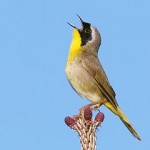 The trees shimmer in an early evening wind that makes it difficult to see the small bird flitting to and fro, branch to branch. “There! That open twig,” I say. “I see it!” Emily exclaims, quickly taking the binoculars from me and adding blue-gray gnatcatcher to her beginners life list. This walk is a meditation.
The trees shimmer in an early evening wind that makes it difficult to see the small bird flitting to and fro, branch to branch. “There! That open twig,” I say. “I see it!” Emily exclaims, quickly taking the binoculars from me and adding blue-gray gnatcatcher to her beginners life list. This walk is a meditation.
Emily and I have taken up birding, me again after a long break from the hobby that dominated my teens, her fresh–a blank life list that can be filled in even after a casual walk in the park. This is her first spring migration and the flow of check marks is constant, with many more to come. I am determined to show her the fiery black and orange of the blackburnian warbler. I can’t wait for her to see a rose-breasted grossbeak with its crimson stained chest. I haven’t seen either of these birds in over a decade.
Coming back to bird watching I am reminded that birding has always been a way for me to let go–a meditation in motion. Emily has experienced this contemplative side of the sport as well, commenting that birdwatching creates a kind of focus and attention that lets the mind rest in other ways. Everything is centered on spotting a bird, identifying it, marveling at even the grayest, drabbest feathered wonder and then awed by the occasional flash of bright color.
Birding is active contemplation that puts the body and mind at rest, opening a door for some deeper work to be done inside. It is a walk first of all, which means that it captures the mind at its best. In his book Brain Rules John Medina says that the brain is most able to learn, to remember and think clearly when the body is moving. That is why so many writers, scientists and other creatives have been known for their walking. C.S. Lewis is said to have walked everyday no matter the weather–it was essential to his creativity.
But in addition to the walk there is also the watching. A bit of movement, an out of place shape in the canopy, the flit of a bird across the path–one must pay attention or miss something. This adds an intense focus to the walk unlike an unstructured stroll. Birding is a way of being in the woods that plays into the many million year history of our species as hunters and gathers. No one survived without paying intense attention to what was going on, everyone was a watcher.
I told a priest friend of mine about this new family activity of bird watching. “It’s like a labyrinth,” he said, “the point isn’t getting through the maze but that is what creates the focus that allows the mind to rest.” Searching through the trees we are given the gift of a kind of mental quiet–a place in which we can relax into the Sabbath world of the divine. Birds have long been considered messengers of the gods. We’ve been learning to watch and listen for what message they may have.












